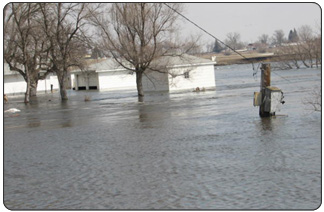Guidance for 2009 H1N1 Flu
Novel influenza A (H1N1) is a new flu virus that was first detected in April 2009. The virus has sparked a growing and expanding outbreak of illness throughout the United States and worldwide. On June 11, 2009, the World Health Organization (WHO) signaled that a global pandemic of novel influenza A (H1N1) was underway by raising the worldwide pandemic alert level to Phase 6. This action was a reflection of the spread of the new H1N1 virus, not the severity of illness caused by the virus. At the time, more than 70 countries had reported cases of novel influenza A (H1N1) infection and there were ongoing community level outbreaks of novel H1N1 in multiple parts of the world. Since the WHO declaration of a pandemic, the virus has continued to spread, with the number of countries reporting cases of novel H1N1 nearly doubling. more

Cannonball River from bridge on State Route 8 in North Dakota. Photo courtesy USGS North Dakota Water Science Center. For more photos and video click here. Hi-Res
The Department of the Interior and its agencies around the country, in cooperation with state and local partners, are acting to help citizens threatened by the record-setting Midwest floods in ways ranging from providing the streamgage and satellite data used in weather predictions to conducting search-and- rescue operations in boats usually used in national parks and wildlife refuges. more
Interior bureaus and offices respond to thousands of emergency incidents each year. Key events in 2009 already include Mt. Redoubt volcano in Alaska, and response to flooding in the upper Midwest. more

